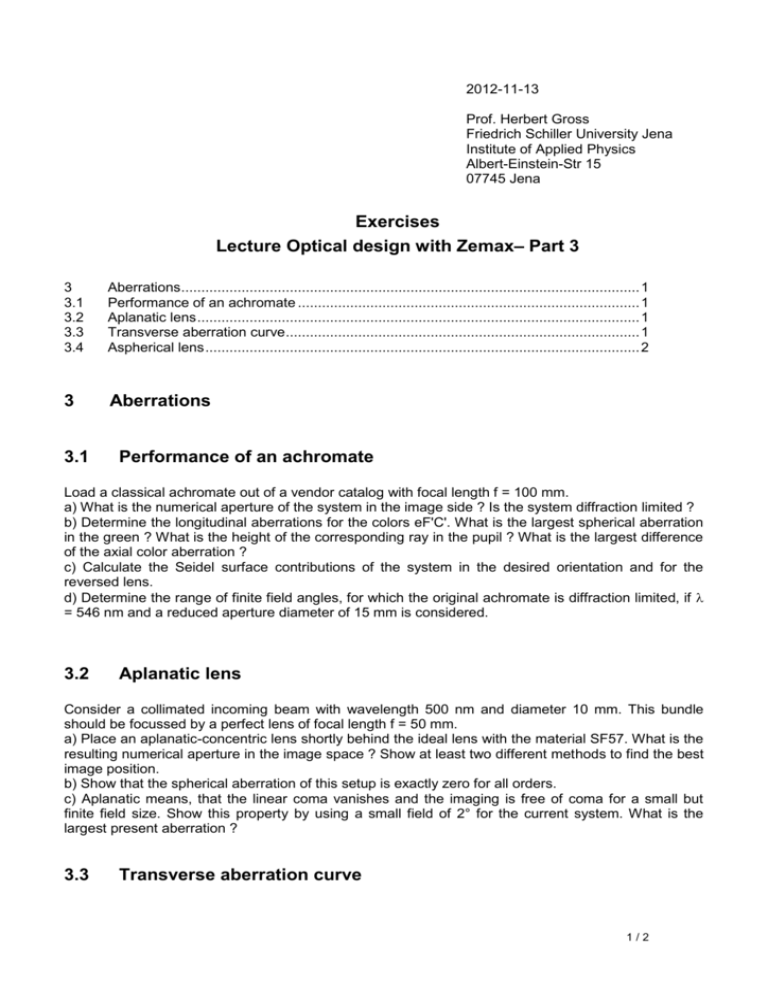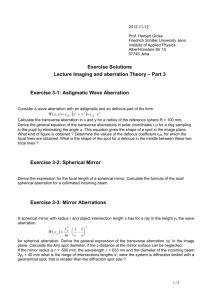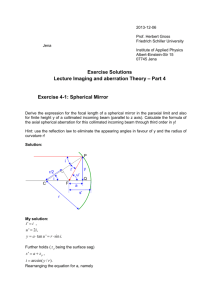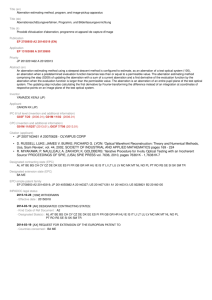ODZ_Optical design with Zemax Exercise 3
advertisement

2012-11-13 Prof. Herbert Gross Friedrich Schiller University Jena Institute of Applied Physics Albert-Einstein-Str 15 07745 Jena Exercises Lecture Optical design with Zemax– Part 3 3 3.1 3.2 3.3 3.4 Aberrations .................................................................................................................. 1 Performance of an achromate ..................................................................................... 1 Aplanatic lens .............................................................................................................. 1 Transverse aberration curve ........................................................................................ 1 Aspherical lens ............................................................................................................ 2 3 Aberrations 3.1 Performance of an achromate Load a classical achromate out of a vendor catalog with focal length f = 100 mm. a) What is the numerical aperture of the system in the image side ? Is the system diffraction limited ? b) Determine the longitudinal aberrations for the colors eF'C'. What is the largest spherical aberration in the green ? What is the height of the corresponding ray in the pupil ? What is the largest difference of the axial color aberration ? c) Calculate the Seidel surface contributions of the system in the desired orientation and for the reversed lens. d) Determine the range of finite field angles, for which the original achromate is diffraction limited, if = 546 nm and a reduced aperture diameter of 15 mm is considered. 3.2 Aplanatic lens Consider a collimated incoming beam with wavelength 500 nm and diameter 10 mm. This bundle should be focussed by a perfect lens of focal length f = 50 mm. a) Place an aplanatic-concentric lens shortly behind the ideal lens with the material SF57. What is the resulting numerical aperture in the image space ? Show at least two different methods to find the best image position. b) Show that the spherical aberration of this setup is exactly zero for all orders. c) Aplanatic means, that the linear coma vanishes and the imaging is free of coma for a small but finite field size. Show this property by using a small field of 2° for the current system. What is the largest present aberration ? 3.3 Transverse aberration curve 1/2 2 Establish a system with an ideal lens of focal length f = 100. mm, a wavelength of 600 nm and a collimated input bundle of diameter 10 mm. a) Define the slider option with the image distance as a variable. Open the transverse aberration chart with a fixed scale of 100 m. What happens with the aberration curve, if the slider is moved ? b) Now introduce a thin glass plate in front of the perfect lens and define one side as a Zernike surface with coma as type (c8) of one wavelength. What is now the result for the moving slider ? Explain the result, if c7 is taken instead of c8. c) If now spherical aberration is introduced by the plate in selecting c9, what is seen for the defocus ? Open also a spot diagram with fixed scale. Determine the best image plane for an overall small spot diameter ? 3.4 Aspherical lens Load the catalof lens A20-18HPX form Asphericon. a) What is the residual correction in wave aberrations and in spot size ? b) Show, that the asphere is sensitive for finite field sizes by introducing a field with angle 0.1°. What is the dominating type of aberration ? c) What is the highest order of the chosen Taylor expansion ? Calculate the performance on axis , if the three highest expansion coefficients are set to zero. Is the system still diffraction limited ?











